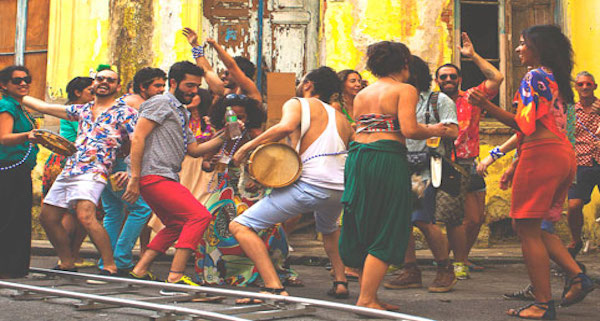February Festivals Around the World: Carnival in Brazil
- by Laura Miller

Comprising the largest festival in the world full of colorful costumes, hot summer heat, and enough sexual energy to fill the Sambodromo three times over, is Carnival in Rio de Janeiro. In classic Brazilian style, the country is enveloped in a week-long vibrant celebration of history, culture, and communal pride. From rambunctious street parties to lavish masquerade balls, everyone is involved in the holiday’s heated festivities.

Tell Me More…
Carnival originated from the Italian Catholic tradition and was brought to Brazil by Portuguese colonization in the 1600s. Carnival is the final indulgence before Ash Wednesday of Lent, the beginning marker of a 40 day period of resisting earthly pleasures before Easter. In present day, there is not a place one can go where crowds aren’t gyrating together, rhythmically moving through street parades sipping on vodka popsicles or a cold beer.
However, Carnival was initially intended for the upper-class and was a segregated celebration until the 20th century. The Afro-Brazilian population would celebrate in the streets separate from the wealthy, creating their own traditions almost in a mockery of the distant elite. Instead of religious finery, it was colorful feathers and Afro-drum beats. In fact, before samba was the dance of Brazil, it was initially the dance of the poor. This all paved the way for what we now know as the Brazilian Carnival.

Did someone say Samba?
Samba is the center of Carnival life. The city’s top samba schools train for months on end to perform in the final parade at Sambodromo. Under the watchful eye of forty critical judges, samba dancers leave it all on the floor for the chance at being crowned champion. First opened in 1984, Samadromo seats up to 90,000 people and was designed by the famous Brazilian architect, Oscar Neimeyer. As tens of thousands of people take to the stands, filling up stadium style seats to luxury suites, hundreds of samba dancers are prepping for the biggest moment of the year.
Each float is escorted by 200-400 drummers, with each dancer covered in covet-worthy costumes full of dazzling headdresses and sparkling accessories. Carnival is truly a communal event as the various communities of each featured samba school rally together to build the float, sew the costumes, and even act as security for the dancers. Excitingly for the visiting foreigner- if one is willing to put in the weeks of hard work- some samba schools are open to letting the visiting international community join in on the fun.

How to get in on the action
While the pinnacle of Carnival takes place at Sambodromo, the party doesn’t stop or end there just because the parade does. Literally millions of people take to the streets in various neighborhoods as blocos, aka Brazilian samba street parties, parade through town. Drink cachaca (Brazilian rum) with the locals, make a homemade costume (or at least don something colorful) and join the party.
Some are themed with certain costumes and colors, others are impromptu as hoards of people gather with old school boom-boxes, drums, and any other kitchen utensil to play a beat on. One of the most famous blocos, The Cordão da Bola Preta, attracts nearly one million people to the city center as everyone is dressed in the established theme of black and white polka dots. Whether you do your research and pick a bloco location, or just walk out your front door- one is guaranteed to stumble upon a rowdy time. Just make sure to bring bottled water as temperatures can soar above 100 degrees.
For the traveler with a larger budget and a taste for the finer things, Carnival still gives the opportunity for a taste of the Portuguese elite in one of the many balls hosted around the city. Hosting the Baile Glamurama is the Museum of Modern Art. Here costumes are required and professional samba performances might as well be too, as masterful dancers command the stage throughout the night. Or galavant over to the rambunctious Scala Gay Gala, the city’s largest LGBT Carnival event.
Lastly, the astounding and historical Copacabana Palace Hotel, hosts the yearly Magic Ball where evening gowns, tuxedos, or elegant costumes are required. Dress in your best seaside elegance as you sip on refreshing cocktails whilst taking in the sunset over ocean front views.

Wait. But isn’t it canceled this year?
Yes- with much chagrin and sadness, due to COVID19 Carnival festivities are cancelled this year and set to be rescheduled in 2022. But that doesn’t mean one can’t bring Rio to their own home.
Try one of these Brazilian cooking recipes.
Watch this samba performance and then learn your own basic steps.
Or listen to the musical stylings of Antonio Carlos Jobim (technically he’s the father of the bossa nova- but you get the point)
Watch this video from last year’s celebrations, and be transported to the streets of Brazil!
Carnival in Rio de Janeiro is the biggest festival in the world. It beckons people from all across the globe to get a taste of Brazil’s vibrant culture, colorful music traditions, and lively holiday festivities. Spend your day swaying in the streets late into the night. Or be awed by Brazilian elegance. Whatever you choose, Carnival will leave one astounded, undoubtedly delightfully exhausted, and boarding the plane home wondering if it was all even real…and inevitably wanting more.
About the Author
Laura is a teacher, traveller, writer, musician, and all around human. She believes travel is a means of bringing people together across lines of difference, moving us towards a more compassionate world. Learn more about Laura on her Instagram or website.
Comprising the largest festival in the world full of colorful costumes, hot summer heat, and enough sexual energy to fill the Sambodromo three times over, is Carnival in Rio de Janeiro. In classic Brazilian style, the country is enveloped in a week-long vibrant celebration of history, culture, and communal pride. From rambunctious street parties to…
